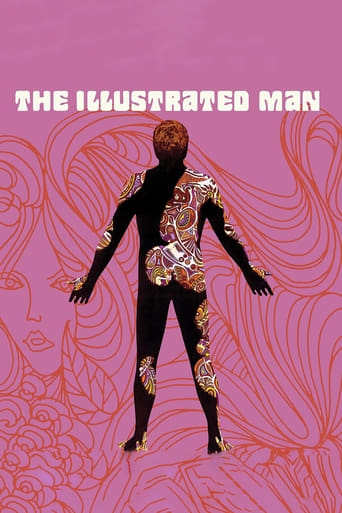

It's funny watching the elements come together in this complicated scam. On one hand, the set-up isn't quite as complex as it seems, but there's an easy sense of fun in every exchange.
... View MoreI have absolutely never seen anything like this movie before. You have to see this movie.
... View MoreBy the time the dramatic fireworks start popping off, each one feels earned.
... View MoreThe storyline feels a little thin and moth-eaten in parts but this sequel is plenty of fun.
... View MoreAfter watching "The Illustrated Man", I did a little research on it, and discovered that writer Ray Bradbury - whose work was adapted for this movie - disliked this movie. Although I have not read any Bradbury, I think I can see where his dislike came from. The main problem with this movie is that it is often much too slow and more often than not lacks any serious bite. The first story (The Veldt) certainly suffers from those problems, coming across as really dull and having a so-called twist ending that's no surprise. The second story (The Long Rain) actually gets to a good start, but suffers from some confusing details as well as a frustrating ending. The third story (The Last Night Of The World) has a good idea, but like the first story suffers from a slow pace and a so-called twist ending that you'll predict long before it happens. The linking footage that connects the three stories is also too slow and long. Whether or not you're a Bradbury fan or not, more likely than not you'll be disappointed with this movie... unless you've ever wanted to see Rod Steiger do nudity.
... View MoreI recently saw this on TCM April 19th, 2012. I haven't seen it in at least 20 years and wanted to see if I saw anything redeeming in it that I didn't notice before. There was absolutely nothing here to change my mind and it still is a ponderous film. Rod Steiger just wasn't right for the part and just because one uses futuristic backgrounds doesn't make a film science fiction. Science fiction can be in the past, present and obviously the future, but it's the idea that counts, the feeling. None of the stories offered any wonder, only depressing clichéd vignettes and endings. Even the "reality" portions of the film were torture to watch. So now I'm good until 2032!
... View MoreLyrical language, though it may make for unforgettable literature, does not necessarily make for great movies. In the Sixties Ray Bradbury was America's premier fantasist, for excellent and unarguable reasons. All of the familiar adjectives used by his reviewers - lyrical, poetic, haunting, charming and etcetera- were (and are) true. He wrote GREAT fantasies, and we all, all of us who were his fans in the Sixties, we all wanted to see movies made from the stories. We looked forward to The Illustrated Man with huge and pleasurable anticipation. I don't believe that it occurred to any of us that our own, personal visualizations were not necessarily shared by all other readers. And certainly not, it turns out, by film makers.Almost without exception, the screen adaptations of Bradbury's stories failed, to one degree or another. The Illustrated Man is probably the worst of the lot, excepting the dismal Twilight Zone segments. The script is bad, yes, but the design is worse - an ugly and dated "Sci-Fi" Hollywood modernism- unbelievable a decade before this movie was made, and laughable in 1969. Not surprisingly the best segments are those in which Steiger and Bloom are simply allowed to act their characters. And as other reviewers have pointed out, those scenes were hardly Oscar-bait.Even so, it's worth watching- as a failed example. Fahrenheit 451 is just as bad, and even more turgid, if possible. The TV adaptation of The Martian Chronicles is much better, a real attempt at a faithful rendering. But the absolutely best Bradbury adaptation is the Disney film of Something Wicked This Way Comes, and those who dismiss it as a "kid movie" are, I think ignorant of Bradbury's work. It's just terrific.
... View MoreIt's interesting seeing the other comments on this movie; this is probably one of those films that polarizes people (Uh, I don't mean it makes them magnetic or anything, just people either really like it or really don't...) (cough) Anyway, as I was saying, the people who seem to like nice, tidy, non obscure, little 'Star Wars' like films, will not like this one much. And, quite fairly, it is honestly a matter of taste (bad : ) Just Kidding. No, this film is very dark, and heavy; and as one other reviewer quite accurately states, Rod Steiger's character is not very pleasant at all. But, that does fit the theme and mood of the movie. Remember, this is one of Ray Bradbury's darker, serious, less pretty books. Hey, the dude can be one of the most beautiful, allegorical, poetic writers on the planet; and he can write things that literally make your heart yearn for wind swept Autumn days with boys chasing each other through piles of golden leaves. Wow, that wasn't too bad : ) Anyway, you get the picture; this is NOT one of those.The little stories within the main story are chilling, serious, and have heavy elements of bad futures and horror. So, if you like your Science Fiction light, forget this. If you like it where it leaves you kind of like Harlan Ellison's stories do, then you'll love it.It just depends on how much of a wussy you are : ) No, just kidding;I like the sweet, fun stuff too.
... View More